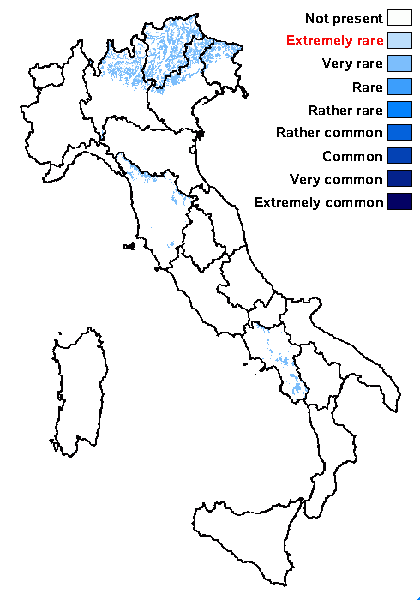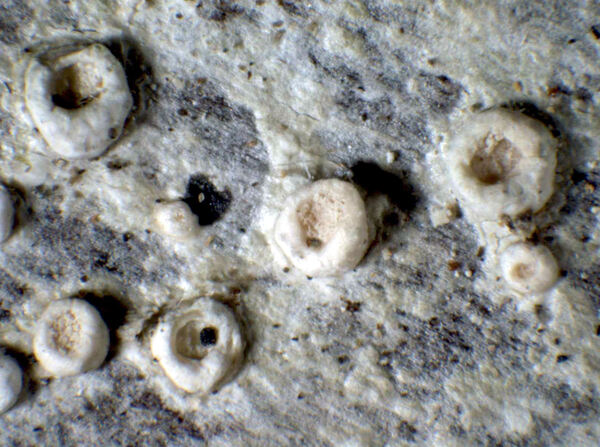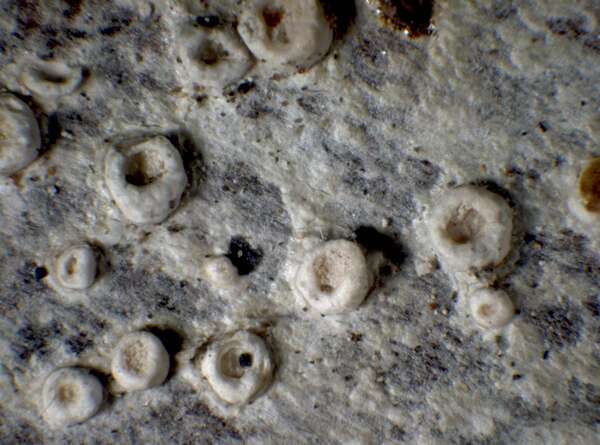Pertusaria carneopallida (Nyl.) Nyl.
Anzi ex Nyl., Flora, 51: 478, 1868. Basionym: Lecanora carneopallida Nyl. - Bot. Not.: 183, 1853.
Synonyms: Cryptolechia carneolutea auct. non (Turner) A. Massal.; Pertusaria leptocarpa Anzi; Pertusaria protuberans (Sommerf.) Th. Fr.
Distribution: N - Frl (Tretiach & Carvalho 1995), Ven (TSB 7824), TAA (Nimis & al. 2015, Nascimbene & al. 2022), Lomb. C - Tosc. S - Camp.
Description: Thallus crustose, endosubstratic or thinly episubstratic, smooth or slightly tuberculate, continuous to faintly cracked, grey, yellowish-grey or yellow-green. Apothecia lecanorine, 0.4-0.7 mm across, immersed in flattened thalline warts, usually 1 per wart, with an expanded, at first flat then convex, pink or red-brown, at first pruinose, then epruinose, to 0.6 mm wide disc and a stellate or lobate thalline margin encrusted with crystals of calcium oxalates, that at first covers the disk, finally sometimes becoming excluded. Epithecium colourless, K-; hymenium colourless to faintly pink; paraphyses thin, richly branched; hypothecium colourless. Asci (4-)8-spored, broadly cylindrical, the apex with a broad ocular chamber, the outer sheath K/I+ blue, otherwise K/I-, with an inner extensible layer, Pertusaria-type, with uni-or bi-seriately arranged spores. Ascospores 1-celled, hyaline, ellipsoid to fusiform, (16-)28-42 x (10-)15-24 µm, the single wall 2-5 µm thick laterally, 5-10 µm thick at apex. Photobiont chlorococcoid. Spot tests: cortex K-, C-, KC-, P-; medulla C+ red, KC+ red (reactions often faint). Chemistry: medulla with variable amounts of gyrophoric acid. Note: a cool-temperate to boreal-montane lichen found on smooth-barked hardwoods in upland areas. It is included in the Italian red list of epiphytic lichens as “Endangered” (Nascimbene & al. 2013c).
Growth form: Crustose
Substrata: bark
Photobiont: green algae other than Trentepohlia
Reproductive strategy: mainly sexual
Commonnes-rarity: (info)
Alpine belt: absent
Subalpine belt: extremely rare
Oromediterranean belt: absent
Montane belt: very rare
Submediterranean belt: absent
Padanian area: absent
Humid submediterranean belt: absent
Humid mediterranean belt: absent
Dry mediterranean belt: absent

Predictive model
Herbarium samples
Growth form: Crustose
Substrata: bark
Photobiont: green algae other than Trentepohlia
Reproductive strategy: mainly sexual
Commonnes-rarity: (info)
Alpine belt: absent
Subalpine belt: extremely rare
Oromediterranean belt: absent
Montane belt: very rare
Submediterranean belt: absent
Padanian area: absent
Humid submediterranean belt: absent
Humid mediterranean belt: absent
Dry mediterranean belt: absent

Predictive model
| Herbarium samples |
 INDEX FUNGORUM
INDEX FUNGORUM
 GBIF
GBIF
 DOLICHENS
DOLICHENS





